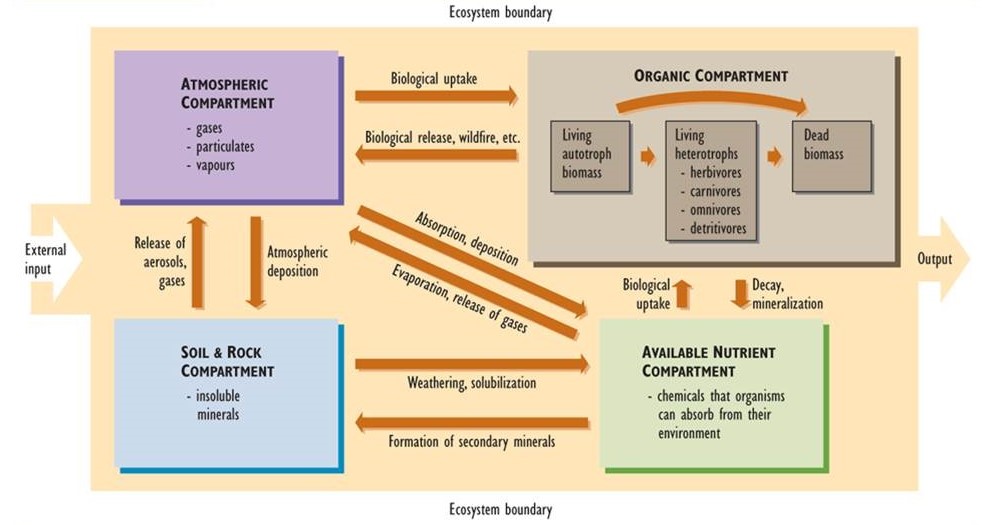They are eaten by primary consumers which are in turn eaten by secondary consumers. This piece should list some of the organisms traits that were passed on from its parents describe how those traits enable the organism to interact in its environment to meet its needs and describe any influence the environment has on the organisms traits.
Nutrient Cycling Crandall Park Trees
Matter refers to all of the living and nonliving things in that environment.

. Energy is passed along the food web from larger organisms to smaller ones until it reaches microbes which are not able to consume organic material. Provide building blocks and energy that organisms need. The nutrients are taken up by plants through their roots.
For example rain forest plants are adapted to use the ample water and sunlight in the production of nutrients. What is the flow of matter. ENERGY LOSS IN THE FOOD CHAIN AND FOOD WEB.
This directly results in the type of organisms that can be found. They are then eaten by tertiary consumers and in a long food day these can be eaten by quaternary consumers. The plants use these nutrients for their own growth and development and in turn the nutrients that make up the plants may then be passed to animals that feed on them.
Abiotic factors include temperature water soil and air. Decomposers break down dead plant and animal matter. Then bacteria reduce the detritus to nutrients.
Decomposers work at every level setting free nutrients that form an essential part of the total food web. Soil The type of soil available in an area determines the type of vegetation. Each of these organisms has its own trophic level.
This energy is then passed on to the rest of the organisms in the environment by the food chain and food web. Convert into forms living cells can use Primary producers Essentialto flow of energy through biosphere store energy in forms convenient for organisms that eat them Examplealgae get energy from sunlight turn it into nutrients that can be eaten used for energy by animals such as a copepod. Plants capture this energy and manufacture food by the process of photosynthesis.
Are needed by organisms to carry out life processes. The biotic factors of an ecosystem include all the populations in a habitat such as all the species of plants animals and fungi as well as all the micro-organisms. Decomposers break down dead plant and animal matter.
Interactions among organisms and between organisms and their environment. In ecosystems matter and energy are transferred from one form to another. Up to 24 cash back Biologists describe nutrients as moving through cycles because the substances a.
When living things die. Energy is passed between organisms through the food chain. Producers supply nutrients to.
Get energy from sunlight or chemicals. Plants are eaten by herbivores which gain nutrients from the plants that are used for growth. Organisms which feed on plants or other animals are known as consumers.
Herbivore as an animal that gets its energy by eating plants. Each stage of a food chain is called a trophic level. Consumers must obtain their nutrients from sources other than the environment.
Nutrients and living matter are passed from producers to consumers then broken down by decomposers. The nutrients pass to higher level consumers when they eat lower level consumers. Also recall that the nonliving factors are called abiotic factors.
Are passed between organisms and the environment and then back to organisms. Describe the path of nitrogen through its biogeochemical cycle. How do nutrients move through the environment.
In a food web nutrients are recycled in the end by decomposers. In ecosystems matter and energy are transferred from one form to another. Only certain types of bacteria can directly use nitrogen in its gas phase.
The waste and dead matter are broken down by decomposers and the nutrients are recycled into the soil to be taken up again by plants but most of the energy is changed to heat during this process. On average only about 10 percent of energy stored as biomass in a trophic level is passed from one level to the next. Start as simple organic forms that plants need.
Matter refers to all of the living and nonliving things in that environment. You can find an ecosystem in a large body of fresh. This consumer is then eaten by another animal which gains the nutrients from the first.
Every living organism needs nutrients to build tissues and carry out essential life functions. Trophic levels describe the dependence of a given organism on others for survival. Animals like shrimp and crabs can break the materials down to detritus.
The nutrients pass to primary consumers when they eat the plants. Nutrients and living matter are passed from producers to consumers then broken down by decomposers. Producer as an organism that makes its own organic nutrients usually using energy from sunlight through photosynthesis.
Like water nutrients are passed between organisms and the environment through biogeochemical cycles. To compose an informative piece of writing. Food web as a network of interconnected food chains.
Food chains start with producers. Consumer as an organism that gets its energy by feeding on other organisms. Which way does energy flow.
Nutrient Cycling Crandall Park Trees

Energy Flow In Ecosystem Tutorialspoint Carbon Cycle Ecosystems Energy Flow

Chapter 5 Flows And Cycles Of Nutrients Environmental Science
0 Comments